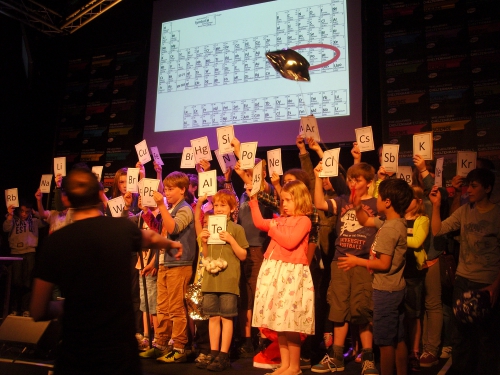If you’ve never been to the Cheltenham Science Festival, it’s well worth putting on next year’s to-do list. With a great mix of science and showmanship, it’s all packed in to a great site right in the middle of town and there’s something for all ages and all knowledge levels – and the sun always shines*.
And as the Royal Society of Chemistry has been a Festival Partner for this year’s scientific extravaganza, I headed quite a long way south and even further west to see two of the packed-out live events we sponsored.
First up was a brilliant, whistle-stop tour through the periodic table with former Famelab finalist, salsa-dancing scientist and all-round bundle of energy
Jamie Gallagher. His
Periodic Success show contains everything from explosions and poisonings to space exploration – and there’s plenty of audience involvement.

Next (before an obligatory ice cream in the glorious sunshine) was a performance of Reverend Ron Lancaster’s legendary
Bang goes the firework lecture. Learn Chemistry aficionados may have seen Ron in action before but it’s definitely worth checking out his sparkling
pyrotechnic lecture we recorded earlier in the year and broke up into
short clips to explain the chemistry in fireworks.
That was to mark his 50 years working as a chemistry teacher, vicar and firework manufacturer, so RSC Chief Exec Dr Robert Parker presented the ‘master blaster pastor’ with a blue RSC
Chemical Landmark plaque as recognition of his contribution to chemistry and pyrotechnics.
To say thanks for putting on the show at Cheltenham for us, we gave Revd Ron a personalised
Learn Chemistry labcoat, not forgetting to sew the pockets up so no rogue explosive materials end up slipping in!

Now I have to admit I haven’t always known quite how important chemistry is to making fireworks – from the basics of gunpowder to nitrocellulose and picric acid in producing colours, there’s a lot of chemistry to learn if, like Revd Ron, you want to be chosen to be the company to put on fireworks displays at events like the London Olympics and the Queen’s Diamond Jubilee.
And finally, while Cheltenham was a truly explosive experience for me, it’s not the only festival or event the RSC are involved in. Head to the
RSC events page on our website to keep across what’s coming up in your neck of the woods.
Edwin.
*This is a promise from Jamie Gallagher, so blame him if you get rained on next year!
Edwin Silvester is a Media Relations Executive at the Royal Society of Chemistry
